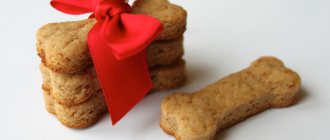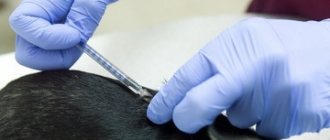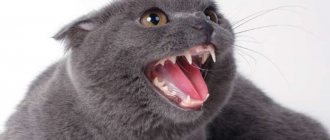Changing teeth in small breed puppies is often accompanied by severe pain, so during this period they especially need attention from the owner.
Moreover, if for some reason a baby tooth does not fall out on time, this can lead to significant bite defects. As a result of such developmental disorders, the puppy will not be able to chew food normally, and this is fraught with problems in the gastrointestinal tract.
Expert opinion
Anna Abramenko
An avid dog lover. Experience in veterinary medicine since 2009.
Ask a Question
When teeth begin to change, it is recommended to regularly examine your pet's mouth, preferably every day. Sometimes you may need the help of a specialist, but some problems can be solved on your own.
Baby teeth
Regardless of the breed, the process of replacing baby teeth with permanent teeth in dogs follows a similar pattern, with the exception of minor details. Serious differences concern only the timing of the beginning and end of these changes.
Puppies are born blind and toothless. Only after 3-4 weeks do the first milk teeth appear on the bare gums.
They resemble thin needles in appearance, and the distance between them may seem too large, but this is normal - the gaps will close as the dog grows older.
The growth sequence is as follows: the canines grow first, then the incisors and premolars begin to form. A complete set is formed by 2-3 months.
Puppies do not have molars.
Understanding the sequence in which the primary set of teeth is formed helps determine the exact age of the dog:
- fangs begin to grow at 2-3 weeks;
- incisors of the upper jaw - 3, lower - 4;
- premolars above and below erupt after 1.5 months.
Correct bite from birth
The adult dentition of a dog consists of 42 teeth. The first “needled” teeth begin to appear at the age of 3-4 weeks, and all of them appear by the end of the 6-8th week. This is a milk set consisting of 28 (14 on each jaw) or 32 (16) pieces, depending on the breed. In the first bite, puppies lack molars. Normal fluctuations in the time of tooth growth are considered to be 1-2 weeks, and not only among representatives of the same breed, but also among puppies of the same litter.
Puppies cut their teeth in the following order:
- on days 20-25, baby fangs appear;
- after 10-15 days the incisors begin to appear;
- Premolars are the last to grow, between 35 and 60 days of birth.
In decorative puppies and small breed dogs, the first teeth usually appear by 40-45 days from birth, i.e. the formation of their entire milk line is delayed.
Signs of a healthy grin
A complete bite is represented by a set of 42 teeth. Deviations in quantity, up or down, are a pathology of genetic development. Twenty-two pieces are located on the lower jaw and another 20 on the upper jaw.
In puppies, the enamel color is white, but in adults it gradually turns yellowish - this is normal. Bite development is determined according to breed standards. A sign of a correct grin is considered to be moderate grinding of the teeth, which does not interfere with eating.
Large dog breeds, such as Rottweilers and Shepherds, often grow a pair of extra canines. This is recognized as the norm. Short-faced dogs have a lack of teeth, which is not a defect.
How many months do dogs change their teeth?
In most cases, the dissolution of milky roots occurs at the end of the 3rd or beginning of the 4th month. The entire “combat kit” appears by the first year of life. The exact time depends on the breed of the pet and some external factors.
Breed characteristics
Despite the general norm for the molar row, the number of teeth in the milk row of large and dwarf breeds differs from each other. The former grow only 28, while the latter grow 32. The remaining differences can be found in the example table.
| Breed | Age of complete change of dentition | Pain during teething | Possibility of complications |
| Large (Labrador, German Shepherd) | Up to 9 months | Low | Low |
| Dwarf (Spitz, Yorkshire Terrier) | Up to 11 months | High | High |
Knowing at what age dogs' teeth change, you can avoid possible complications. If the deviation from the norm is more than 2 weeks, be sure to contact your veterinarian.
External factors
In addition to breed characteristics, other factors are also important. The time at which a dog's teeth change depends on the climate, the quality of food and water consumed, and health status. Delayed appearance and frequent complications are typical for animals from cold regions that receive exclusively soft food and tap water that has not been pre-treated.
Types of bite
The following types are distinguished:
- bulldog (also called undershot);
- undershot;
- normal (or scissor);
- straight (pincer-shaped).
The standards for each variety vary widely, and what is common in breeds like the Pekingese is considered pathological in other species.
bulldog
This overbite is typical in Bull Terriers and Bulldogs, as the name suggests, but is also normal in Pekingese and related breeds.
The structure of the oral cavity is characterized by excessive development of the lower jaw, which protrudes forward. The canines are often exposed with this structure.
Underbite
This type of bite results in insufficient development of the lower jaw, resulting in a large gap remaining between the upper and lower incisors.
This type causes the most problems, as it provokes a number of dental pathologies.
In particular, the most common problem with underbite is the formation of tartar.
Normal
This structure of teeth is determined historically. The ancestors of modern domesticated dogs were forced to get their food by hunting, and for this they had to not only track and overtake prey, but also hold it. This explains the scissor bite.
With this structure, the incisors of the lower jaw are closely adjacent to the back of the upper ones, as a result of which a kind of “lock” is formed. A normal bite is typical for Dobermans.
Among all the varieties, it is recognized as the most “non-problematic”, since the owners of these breeds rarely seek medical help for their pets during the period of tooth loss.
Straight
This type of overbite is unacceptable for most breeds and is considered a serious defect at shows. With a pincer-like arrangement of teeth, the incisors of the upper and lower jaws are located on the same line, as a result of which their ends quickly grind down from pressure on each other.
With this type of bite, molars and canines develop without pathologies.
Expert opinion
Anna Abramenko
An avid dog lover. Experience in veterinary medicine since 2009.
Ask a Question
A pincer-like structure of teeth is normal if it is genetically determined, but it often happens that dog owners themselves develop a straight bite - this happens due to frequent games of tugging with objects.
Dog dental care
By the age of two, plaque and tartar have already begun to form on the dog’s teeth. A change in the color of teeth does not always indicate any violations, but tartar is always bad. You need to know and be able to properly care for the mouth of your four-legged friend in order to avoid problems with dental health.
Dental care for puppies
cleaning the first milk “needles” is not necessary;- It is good to add minerals in the form of phosphorus and calcium to the diet;
- give puppies large pieces of meat as food as soon as they learn to chew themselves (the teeth self-cleaning occurs during the process of tearing and chewing);
- It’s good to add special crackers for gnawing, regular carrots or large beef bones to the puppies’ diet;
- have special toys and devices available so that the puppy can chew something not only at the time of feeding, but also during play;
- Dry food from one month of age is not soaked, but is given in its usual dry state.
Caring for your dog's teeth during shifts
- monitor your bite so that new teeth do not begin to grow before the baby teeth fall out;
- A visit to the veterinarian is required if any abnormalities are detected in the mouth when changing teeth;
- do not play tug-of-war with young dogs that are in a state of renewal of chewing elements and do not force toys out of their mouths - there is a high risk of loosening baby teeth and malocclusion;
- daily inspection of the mouth is encouraged;
- You can gently loosen baby teeth with your finger in dwarf dog breeds, because... It is in these breeds that they are most often found to be “stuck”;
- if baby teeth do not fall out at the time when they are actively changing, it is important to discuss the issue of their removal with a veterinarian;
- Do not let your dog chew on anything too hard so that the baby teeth fall out without causing injury to the gums.
Caring for adult dog's permanent teeth
- if yellow plaque forms, be sure to visit a veterinarian to find out the cause;
- It is mandatory to inspect your pet’s mouth daily for foreign objects between the teeth, unpleasant odor or papillomas on the mucous membranes and gums;
- You can remove detected foreign objects yourself only if you don’t have to put any effort into the procedure itself. If something is tightly stuck, this is the concern of a veterinary specialist;
- To prevent plaque, it is advisable to clean your dog's mouth as often as prescribed by your veterinarian. For these purposes, special pastes and special toothbrushes for dogs are used. You can also use cleaning mixtures that you prepare yourself: 1) mix aloe juice and a 1:1 solution of hydrogen peroxide and add soda until a paste forms. Wipe the surface of the teeth with a finger wrapped in gauze or a special toothbrush; 2) calendula tincture, added to drinking water - calendula herb is poured with 40% alcohol to barely cover it, and infused for 2 weeks. Simply add 1-10 drops to 0.5 liters of drinking water once a day, depending on the size of the dog;
If your dog has been found to have tartar (calcareous deposits near the very root), you should not try to remove it yourself, it is better to contact a specialist. Mild deposits can be cleared by giving your dog special food or rawhide bones. Complex – cleaned under anesthesia by a specialist;- To prevent plaque and tartar in dogs, as prescribed by a veterinarian, you can also use the drug “Stomadex” in courses of 10 days. Use in the same way as for gum inflammation.
In dogs, disruption of the process of changing teeth can lead to unpleasant consequences, so it is better to prevent everything than to then subject your pet to numerous unpleasant medical dental procedures.
Author:
Grinchuk Ekaterina Andreevna veterinarian
What not to do during the period of teeth change
When dogs begin to lose their baby teeth, it is necessary to ensure that a number of conditions are met when interacting with your pet:
- You should not engage your puppy in games the essence of which boils down to tugging objects. This can loosen some baby teeth ahead of time.
- You should not take away from the dog something that he has clenched in his jaws, not wanting to give it back.
- It is best to minimize contact with other dogs due to reduced immunity at this time.
Gum inflammation in dogs
Often a minor inflammatory process of the gums accompanies the entire period of changing teeth in a puppy. Clinically, this process in a puppy is manifested by redness and swelling of the gums, severe drooling, decreased appetite and the development of stomatitis (stomatitis in dogs).
Delayed tooth replacement or “stuck” baby teeth.
Sometimes a puppy’s baby teeth don’t have time to fall out before permanent ones “make their way” into their place. In addition to malocclusion, persistent teeth are dangerous due to additional injuries to the cheeks and inflammation of the gums. When examining the oral cavity, puppy owners discover baby teeth in the jaw at an age when they should no longer exist, as well as two processes from one tooth socket, one of which is baby teeth.
In the event that a dog owner cannot remove a loose tooth himself, it is necessary to contact a veterinary clinic about this problem.
Possible complications
To avoid problems with the formation of a correct bite, the puppy's mouth is regularly examined as new teeth grow.
The process does not always go smoothly, but timely intervention will help the pet safely cope with the changes that are taking place.
Swelling of the gums
The first sign of irritation and swelling of the oral cavity is excessive salivation and redness. In addition, the puppy does not eat well, refuses to play and does not cooperate.
Expert opinion
Anna Abramenko
An avid dog lover. Experience in veterinary medicine since 2009.
Ask a Question
To relieve pain, it is necessary to treat the puppy’s mouth with an antiseptic for sanitation of the oral cavity. Veterinarians usually prescribe a course of Stomadex in this case.
Delayed loss of primary teeth
Because of this, dogs develop an incorrect bite, as permanent teeth grow next to milk teeth that did not fall out in due time.
In addition, such a delay is fraught with irritation of the gums and the formation of ulcers on the inside of the cheek, since improperly grown fangs can touch them when chewing food. Most often, this complication occurs in small and medium-sized short-faced breeds.
Expert opinion
Anna Abramenko
An avid dog lover. Experience in veterinary medicine since 2009.
Ask a Question
If necessary, you can speed up the process by carefully loosening old teeth. If this does not bring the desired results, you should seek help from a veterinary clinic.
When do dogs change their milk teeth to permanent ones?
The period of replacement of milk teeth in dogs with permanent ones is the most crucial and important moment in the life of your pet. After all, it is not only associated with the intensive growth and development of the puppy, the formation of its exterior and character, but is also associated with the period of greatest susceptibility to various infectious diseases - which is why it requires special attention and control from the owner!
- The change of teeth in large breed puppies begins at approximately 3–3.5 months of age and ends by 6–7 months. In miniature breed puppies, this process is usually more protracted; the onset of teeth change can be delayed and delayed until nine months of age. At the same time small dogs tolerate it less well and often require the help of a doctor.
- Puppies' incisors are the first to begin to change, and they usually complete their full growth faster than other teeth. This occurs from approximately 3 to 5 months.
- The next to “peck” are the permanent canines, which in puppies grow the longest and reach their final size by 6-7 months.
- first grows from the molars . It does not have a milk variant and appears immediately permanent in the fourth or fifth month of a puppy’s life. At the same time, the largest one, the first molar, grows, then all the other false roots and molars.
Table for changing teeth
The process of changing teeth ideally occurs as follows:
- The root of a baby tooth undergoes resorption (dissolves). The fixation of the tooth in the jaw weakens and it begins to wobble.
- At this time, the permanent tooth is actively growing along its canal, pushing out the milk tooth. If it is still firmly held in the gum, a growing permanent tooth may “hatch” nearby and they will remain together in the jaw for some time. If this lasts no more than a week and is not accompanied by painful processes in the gums, you can wait a little. Until the baby tooth falls out and the permanent one takes its place.
- But if the gums become inflamed or the loss of a baby tooth continues for more than a week, you should immediately consult a doctor.
Teeth in two rows
Symptoms of tooth change and process
The onset of tooth loss is indicated by the following behavioral characteristics:
- The puppy constantly chews on something: shoes, furniture, objects left on the floor. You can’t scold him for this, because the puppy is trying to relieve the pain in his gums.
- The former activity and playfulness is replaced by apathy. The pet behaves lethargically, moves little and refuses food.
- A symptom that is directly opposite to the previous one is increased excitability. The puppy becomes restless and fussy.
- The regularity of bowel movements is disrupted.
- Body temperature rises.
- Drooling increases.
Dogs' incisors are the first teeth to fall out because they receive the most pressure when eating. Following them are the molars (also called “true molars”). The last ones to erupt are the premolars.
The process occurs differently in representatives of small and large breeds. Rottweilers, wolfhounds, and shepherd dogs extremely rarely need the help of a veterinarian at this time, which cannot be said about dwarf dog varieties such as Chihuahuas, Brabançons, Shih Tzus, lap dogs, etc.
This is explained by the fact that small breeds feed mainly on soft food, as a result of which their canines and incisors wear out slowly.
The process of loss of baby teeth is noticeably extended over time due to surgical operations, injuries, illnesses, as well as ear and tail docking.
How does the change or eruption of teeth manifest?
Teething in puppies is not painful. The main discomfort is itching in the gums. It is he who becomes the explanation for the fact that puppies chew everything around. To alleviate the condition, it is recommended to prepare in advance special toys for gnawing, special tendon bones or treats in the form of various cartilages. In pet stores or veterinary pharmacies there is a large assortment of different items for scratching gums.
In puppies, the period of the appearance of the first teeth is also usually accompanied by a slight increase in body temperature (up to 0.5 degrees), some lethargy, and sometimes a decrease in appetite. Diarrhea is possible. In any case, you need to contact a veterinarian to assess the general condition of the dog.
The effect of changing teeth on a puppy's health
When baby teeth are replaced with permanent ones, the animal's immunity weakens. During this period, sudden changes in body temperature pose a particular threat to his health: hypothermia and overheating, which means that the duration of walks must be minimized, especially in the cold months.
It is also better to postpone intense training for a while.
Expert opinion
Anna Abramenko
An avid dog lover. Experience in veterinary medicine since 2009.
Ask a Question
To minimize the risk of disease, all necessary vaccinations are given to the pet before its body begins to rebuild.
When do puppies start teething?
When introducing complementary foods, it is very important to note whether dogs have baby teeth. Until this moment, the pet is simply not able to chew solid food, so it is completely dependent on its mother.
The first snow-white teeth appear 20-25 days after birth and are fully grown by 1.5-2 months. The exact timing of eruption depends on the breed. In miniature dogs, this process is slightly delayed, occurring at 5-6 weeks of life.
Helping a puppy through a difficult period
When dogs change teeth, their immunity decreases. For the entire period, it is recommended to protect your pet from stress, intense physical activity, contact with other animals and vaccinations. You should also review your current diet, strengthen oral hygiene measures, and purchase teethers.
Gnawing accessories
A teether is a special device filled with water. Keep it in the refrigerator before use, as the low temperature reduces itching and inflammation. Using a teether, a regular rubber toy, or chewable treats can prevent damage to furniture and valuables.
Please note that it is better to remove dangerous objects away during this period. A baby suffering from itching may accidentally bite the wire and get an electric shock.
Oral hygiene
Regular oral hygiene protects against stomatitis, caries, tartar and other dental diseases. Your baby needs to be taught to brush his teeth to avoid problems in the future.
To clean the enamel, you need to purchase a special toothbrush, veterinary paste or cleaning gel. Move strictly from top to bottom from the outside of the jaw towards the inside.
The procedure should be repeated 5-10 times a month, and every 2 months the pet should be examined at a veterinary clinic. This way you can easily understand whether your dog has baby teeth, or whether the process of replacing them with molars has already come to an end.
Feeding
To form a beautiful and healthy bite, your puppy will need a lot of calcium and phosphorus. When feeding natural foods, be sure to include in your diet:
- veal;
- raw carrots;
- sea fish and fish oil;
- fermented milk products (cottage cheese, cheeses, kefir);
- beef liver;
- spongy bones and boiled cartilage;
- sea buckthorn oil.
The addition of ready-made vitamin and mineral complexes should be discussed with your veterinarian. Otherwise, you risk causing an overabundance of vitamins.
If your pet eats dry food, then it already contains all the necessary elements. All you have to do is focus on the baby’s well-being, combining granules and wet canned food. The former will help relieve itching, and the latter will help reduce the sensitivity of inflamed gums.
Your puppy is teething – how do you know what the symptoms are?
In most cases, the process of teething in a puppy is invisible and painless. The increase in temperature can be short-term and pass during sleep or rest. The owner himself must control the process. To do this, just run your finger along your pet's gums.
Important! The animal’s gums itch in any case, and the dog begins to chew everything it sees to get rid of this sensation.
For this, the owner should stock up on large beef bones (mosles) or special products from the pet store - toys, bones, etc.
The role of teeth in the life of an animal
The dental system of dogs is the main device for the primary mechanical processing of food; its importance is difficult to overestimate. It is adapted for cutting meat like scissors. All breeds, without exception, have sharp and large fangs that are saber-shaped to tear food or prey into pieces.
We recommend this article:
How many teeth should dogs have at different ages?
Cheek molars are necessary for quickly cutting food and gnawing bones. They have a triangular shape and a jagged end that resembles a blade. Premolars are used for tearing and grinding. The incisors are used for biting. Dogs use their front incisors to perform various auxiliary actions, such as catching fleas.
How to help a puppy during teething changes?
Most puppies tolerate tooth changes quite easily. They do not require any special help. The main thing to do is to secure the house and provide the puppy with an opportunity to chew.
It is important to hide everything that should not get into the puppy’s mouth: wires, cables, shoes, sponges, small objects. This is necessary not only because valuables may be damaged, but also because it can be dangerous for the puppy. Your pet may receive an electric shock or accidentally swallow a foreign object.
Buy your puppy rubber rings, balls, use a Kong and treats. Let the puppy chew on what is safe. We recommend various natural SUPERPET delicacies made from venison. They are soft enough to not cause discomfort, but still satisfy your puppy's chewing instinct. Treats made from dried meat can be given chilled, this will also help cope with discomfort in the gums.
If the puppy bites your hands
If your puppy bites your arms or legs, do not scold him. Puppies do not understand that they bite hard and thus hurt. You can teach your puppy not to bite. When he bites you, let him know about it. For example, say “It hurts!” If your puppy stops biting you, praise him and give him a treat. If it doesn't work, calmly walk away from the puppy.
Once your puppy understands that his bites are causing you discomfort, offer him an alternative. Show that you can bite, for example, a rubber toy. Always keep toys handy to distract your puppy.
The teething period is an excellent opportunity to teach your puppy that human hands and feet are not designed for biting. If your pet bites your hand while playing, offer him a toy. If he continues to bite you, stop playing. Sometimes a puppy bites not because his gums hurt, but in a fit of excitement. By stopping the play, you show the puppy that his behavior is not desirable.











